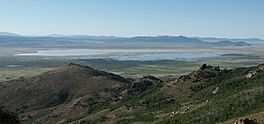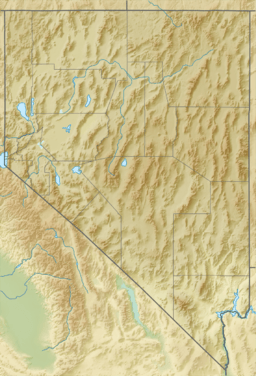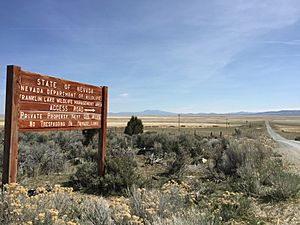Franklin Lake facts for kids
Quick facts for kids Franklin Lake |
|
|---|---|

Franklin Lake
|
|
| Location | Elko County, Nevada |
| Coordinates | 40°21′33″N 115°23′54″W / 40.35917°N 115.39833°W |
| Type | sink |
Franklin Lake is a special kind of dry lakebed, called a playa, located in Elko County, Nevada, USA. It gets its water from the Franklin River.
You can find it on the east side of the Ruby Mountains, about 65 miles (105 km) southeast of the city of Elko. It's also right next to the Ruby Lake National Wildlife Refuge, which is a protected area for wildlife.
Most of the land around Franklin Lake is privately owned. However, some parts are looked after by groups like The Nature Conservancy and the Bureau of Land Management. The Nevada Department of Wildlife manages a special area called the Franklin Lake Wildlife Management Area.
This whole area is huge, covering about 15,400 acres (6,230 hectares). It has many different types of natural homes for plants and animals, like wet areas called wetlands, a lake that sometimes dries up (an ephemeral lake), marshy spots, forests along rivers (riparian woodland), dry alkali lakebeds, shrublands, and grasslands.
Plants and Animals of Franklin Lake
Many different plants and animals live in the Franklin Lake area. A type of tall grass called Scirpus validus (also known as softstem bulrush) grows very well here.
When the area is wet, hundreds of thousands of waterfowl (birds that live near water) come to visit Franklin Lake.
Bird Species at Franklin Lake
Many kinds of birds can be seen at Franklin Lake. These include the American Avocet, Greater Sandhill Crane, and different types of terns like the Forster's Tern, Caspian Tern, and Black Tern.
Other birds you might spot are the Greater Sage-Grouse, Franklin's Gulls, American White Pelican, Brewer's Sparrow, and Sage Sparrow. This area is a very important stop for many migrating birds.
How Franklin Lake Got Its Name
Franklin Lake was named in honor of President Franklin Pierce. It was given this name by Lieutenant Edward Griffin Beckwith in 1854. He was part of an exploration trip known as the Beckwith Expedition.



